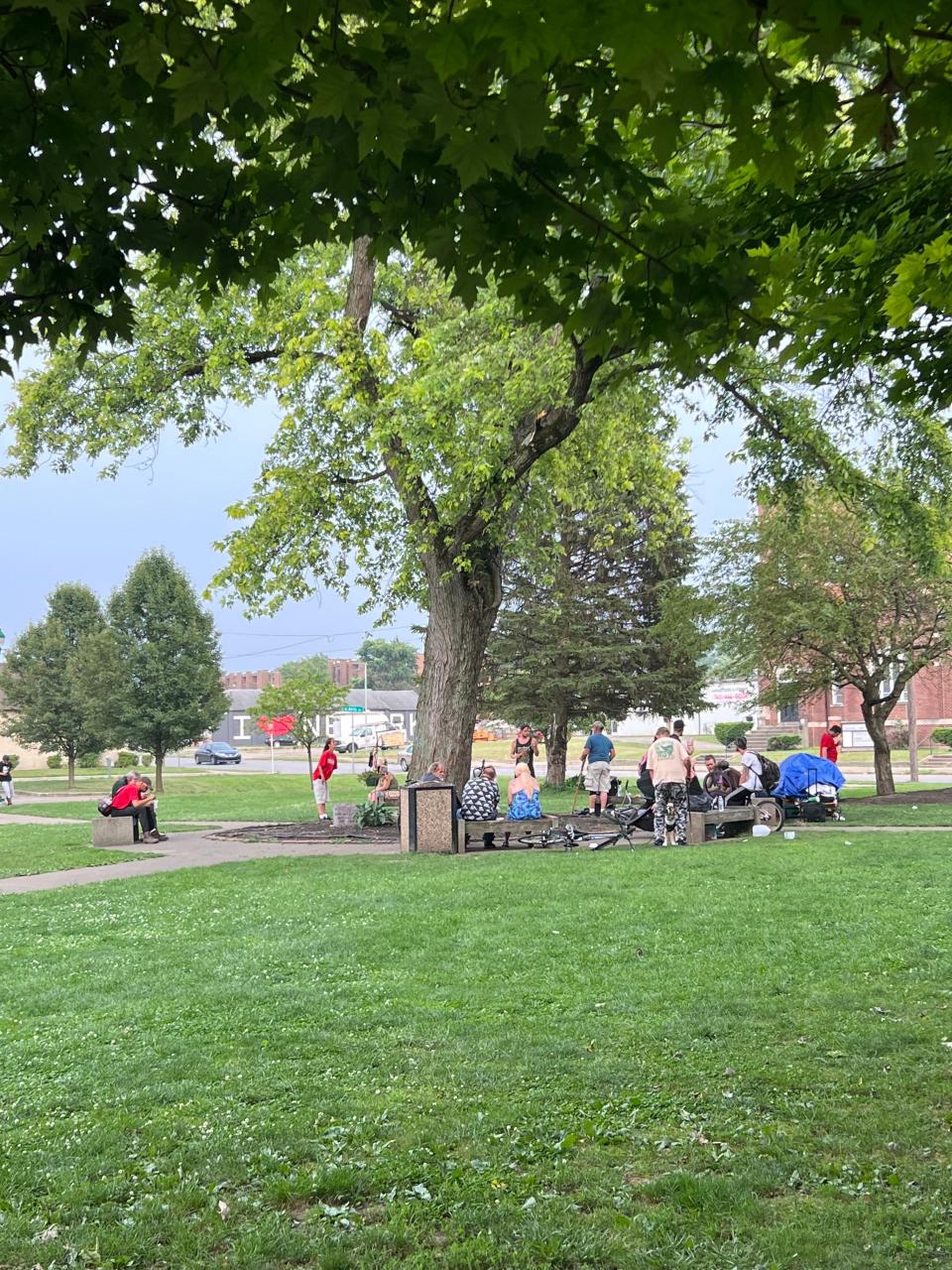Hope prevails as poverty, homelessness and overdoses are on the rise in Licking County

Mike Young resumes painting a mural he’s been working on for the last eight weeks. He has just returned from a daily probation program to the Salvation Army Shelter on East Main Street in Newark, where he lives.
The bright colors in the mural on a wall in the Salvation Army dining room portray one positive image after another. Young carefully outlines the final letters of the word “good.”
For Young, 46, the past few months have brought him stability that he hopes will set him on a path to success and away from the one that repeatedly led him to trouble.
“When it’s all said and done, it comes down to structure; structure is all that matters,” he said.
The structure that Young needed in his life is the probation program that has kept him out of trouble — and jail — for the past three months.
In early April, Young was arrested on several charges, including drug possession, which exacerbated his ability to find and afford housing. Even as development booms and jobs pour into Licking County, Young is among the rising number of people in Licking County who struggle to find housing due to substance use disorder, prolonged poverty cycles and the tight housing market.
Young has lived all three. And even with his efforts to stay sober and out of trouble, he still might not be able to afford a home in a county where average rental prices have gone up 25% in the past couple of years.
A recent report by the United Way of Licking County shows that 10% of Licking County residents live in poverty, and about 27% live one paycheck away from losing their homes. That report said that a “household survival budget,” which represents the minimum cost of living here, is $69,516 a year for a four-person household. And yet, in 2021, 3,041 families in Licking County lived in poverty, according to the 2023 Ohio State of Poverty Report.
Young was held in the Licking County Jail for three weeks in April before he could pay his $3,000 bond for release pending trial. His future appeared grim. Young faced the possibility of spending the next eight years in prison, but then hope arrived in the form of Young’s pre-trial parole officer, Brandy Nelson.
Nelson told Young about a “day-reporting program” offered through the Licking County Adult Court Services. This would provide Young the opportunity to address some of the issues he’d been dealing with his whole life and, hopefully, demonstrate personal growth to the court on judgment day.
Young’s attorney asked the court for a continuance of Young’s July hearing date to give him a chance to participate in the program that would help him deal with trauma and addiction. His new date is set for Aug. 25.

“At first, the reason I was doing this was to avoid getting locked up again, but now, the truth is that I’m doing this for me, my family and for my future self,” Young said.
This outlook would’ve seemed foreign to Young 20 years ago.
“Since the age of 15, I’ve lived like an adult; I never really had that gradual transition other kids have,” Young said. “It felt like one day, I was a kid going to the park, then the next, I was running from the police at 13.”
Young grew up in the Washington Square apartments on Eastern Avenue with his mom, stepdad and four siblings.
“My childhood was very unstable. Everything from domestic violence to cops to constantly moving around — even had a few stints in foster care somewhere in there,” Young said.
Young said that his family’s financial situation left him looking for ways to make ends meet on his own. Realizing this at an age when working a real job wasn’t a possibility, Young took to an alternative form of money-making.
That included theft, flipping stolen items, and in some cases, helping others deal drugs.
“From a young age, I’ve been deeply embedded in the streets,” he said.
The lifestyle and mentality that Young learned growing up didn’t leave him when he turned 18. Just a few months into adulthood, Young found himself in prison for the first time, on an unauthorized use of a motor vehicle charge.
“The first time locked up is foreign,” he said. “It’s like going to a different school and navigating the lunch room. After a while, though, that initial feeling of uncertainty wears off and it becomes normal.”
Young’s first time wouldn’t be his last.
“I’ve spent almost 10 and half years of my life behind bars,” Young said.
He says he became complacent with his life in and out of prison.
“When life in prison becomes routine — like it did for me and many like me — I felt as though change can’t happen, like those locking you up want it to. I’ve grown more as a member of society in the past three months in this day-reporting program than I had in over a decade in prison.”
Back in April, after bonding out of jail, Young enrolled in the day-reporting program in hopes of changing his ways. He knew that if he didn’t change, history would likely repeat itself.
The Licking County Adult Court Services Day Reporting Program provides offenders with a restorative alternative to incarceration. In the program, participants enjoy drug and alcohol counseling, mental health services and professional/job placement assistance.
“This program isn’t foolproof,” program Director Michele Hamann said. “What I mean by that is, you can’t force someone to change. They have to genuinely want change. Everyone’s different, everyone’s got their own timeline. The best we can do is be by their side with support.”
- - - - - -
Overdose deaths are on the rise in Licking County. During the past six years, 256 people in the county have died because of an overdose. In 2022, 49 of the 58 overdose deaths were caused by an opioid, primarily fentanyl. Fentanyl is a synthetic opioid that is up to 50 times more powerful than heroin and 100 times more powerful than morphine. The drug is an important medicine often prescribed by trained medical professionals as a painkiller, but illicit forms of the drug are sold on the streets.
Sources: Licking County Coroners Office (via Patricia Perry), Centers for Disease Control and Prevention.
- - - - - -
Margin for error
Mike Young had used drugs the majority of his adult life: heroin, meth, cocaine — the full menu.
Like a lot of people who use illicit drugs, Young saw the supply shift from pills to heroin to fentanyl.
“Ten years ago, it was all heroin, and now fetty (fentanyl). That’s not the shift you wanna see,” Young said.

A 2023 report by Harm Reduction Ohio says that during the past decade, Ohio’s illicit drug supply has become increasingly more dangerous, primarily because fentanyl has replaced heroin as the primary opioid.
“It really is concerning,” said Ben Shirley, outreach specialist for Behavioral Healthcare Partners of Central Ohio in Newark. “The margin for error was slim with heroin; there is no margin with fentanyl … just the smallest amount too much, and that’s it.”
According to a Drug Enforcement Agency intelligence report released in 2022, the flow of fentanyl through the U.S. is now far heavier than a decade ago.
The same report noted that the trend of heroin overdose deaths in the U.S. was decreasing, while the overdose deaths from fentanyl was increasing.
The trends in Licking County mirror the national trends. Annual reports examining drug overdoses from the Licking County Coroner's office illustrate the increase in fentanyl-related deaths in the past six years.
Between 2017 and 2022, 61% of all drug overdose deaths in Licking County were attributed to fentanyl alone or other narcotics that contained fentanyl. Last year, 40 of the 58 overdose deaths involved fentanyl.
“These stunning numbers just account for those who are dying from overdosing,” said Patricia Perry, co-founder of the Newark Homeless Outreach.
Young said that, “When you’re addicted to fentanyl, most people would rather die of an overdose than face the dope sickness that comes when you're deprived of the drug in rehab.”
When someone is “dope sick” (suffering from withdrawal from opioids), they can experience a range of symptoms, including intense cravings for opioids, muscle aches, nausea, vomiting, diarrhea, excessive perspiration, anxiety, restlessness, insomnia and overall flu-like symptoms.
Typically, these more intense physical symptoms persist until the drug has exited the person’s system, which can be up to five days.
For Young, this happened in October 2022, when he said he checked into Hope Valley Recovery in Circleville for a 45-day detox treatment and recovery.
“The hardest part of recovery for me was that first week,” Young said. “The staff is there to support you, but for all that physical sickness, you have to go through it on your own.”
Once the fentanyl had left Young’s system, he was put on the opioid prescription drug Suboxone, which reduces withdrawal symptoms and the cravings for stronger opioids. For Young’s recovery, the medication would act as an intermediary treatment before moving to monthly shots of Vitriol.
Vivitrol is a long-acting formulation of naltrexone, which works to block the effects of opioids in the brain. Medication-assisted treatment helps some people sustain recovery and allows them to live their lives. Medicaid paid for the shots.
With a Vivitrol dog tag around his neck, Young explained the power of the medication.
“It’s life-changing,” he said. “It completely takes away your body’s obsession with having the drugs in your system. I’m super grateful to have been put on it, and think it has the potential to help a lot of the people out here.”

While sitting on benches in the shade of a towering tree on the Salvation Army’s lawn fronting East Main Street, Young glanced down at his phone, looking at a “virtual sobriety chip” that displayed the number 97 — the number of days without drugs.
“I haven’t been sober this long in over 30 years — since I was 15,” he said. “Time being sober is power for me. Everyday, I feel stronger, more like the person I’m supposed to be.”
That accumulated time empowered Young recently when he found himself around some people who were using drugs.
“Wasn’t even a question to say no to them,” he said, nodding his head. “I’ve got so many people rooting for me, caring about me, loving me now. I can’t let them down, and I can’t let myself down like that.”
- - - - - -
The number of unhoused and unsheltered people continue to rise in Licking County. In 2019, the number of unsheltered individuals was 45 adults. In July 2023, that number had risen to 100. A point-in-time report released by the Licking County Coalition for Housing in July showed that 18 families in Licking County were experiencing homelessness, and that 91% of the homeless people in Licking County at the time were homeless for the first time. There are no low-barrier shelters in Licking County to take in people with pets or struggling with addiction, only the occasional warming center during the coldest days of winter.
Sources: Licking County Coalition forHousing Point-in-time Count and housing data, United Way ALICE Report.
- - - - - -
Food and shelter at The Salvation Army
Not far from the main railroad tracks running east and west through Newark, nearly 80 hungry residents of Newark file into The Salvation Army for dinner on a hot, humid summer day.
An hour before the 5:30 p.m. serving time, many dinner guests were waiting on the circle of benches under the large oak tree in front of the building.
As guests enter, tri-sectioned trays are filled with sloppy joes, peas and fruit salad. Orange Kool-Aid and lemonade await at the end of the counter, and the drinks prove to be popular on this hot July day.
Serving the dinner guests from across the counter are volunteers and residents of the Salvation Army Shelter. These residents have a rotation of mandatory chores, one of which is assisting with serving meals.
On this night, Young is working on the line, loading trays with generous helpings of everything. He’s been on the other side of the counter and understands their situation.
Dinner guests sit at one of the three tables that stretch 25 feet across the room. Many take a seat with familiar faces.
“You got your crew, and you sit with your people,” said one unsheltered guest at the place they affectionately call “The Sally.”

The Salvation Army serves three meals every day. It had been lunch and dinner until 2019, when it added breakfast. Typically, dinner is the most attended meal, when it serves an average of 100 to 170 guests a day.
This summer, the Newark Salvation Army also organized and ran the Summer Food Service Program, which provided free meals to any child. From June 12 through July 21, Mondays through Fridays, children could pick up free brown bag lunches at nine locations in the city.
“We find that children often go unrecognized within family financial insecurities, so this is our way of recognizing them and their very important need for nutrition,” Salvation Army Social Services Secretary Jeanne Ferrara said.
Ferrara said the program drew an average of 290 children daily for lunch.
The Salvation Army in Newark also is home to a 50-bed shelter, with separate wings for men and women, and a wing for families. It provides them with a bed, clean shower and a host of services.
The shelter is not a low-barrier shelter, meaning residents must pass a background check before checking in. An individual seeking shelter must have no recorded violent offenses within the past year. Additionally, residents are prohibited from using drugs and alcohol on the property, they cannot bring pets or weapons into the facility and they must agree to engage in chores around the building.
When a client checks into the facility, the person is assigned a case manager who works with that person to develop a plan to help solve whatever crisis the person might be facing. This typically manifests in a flexible, 90-day program.
Salvation Army Maj. Timothy Higgins said the goal of the program is for clients to improve their housing and employment situation, ultimately becoming self-sufficient.
“Everyone of our clients is different, and therefore requires a unique plan that works specifically for them,” he said.
Young checked into the men’s wing of the shelter in May 2023.
Since moving there, his schedule has reached a heightened level of structure. Every weekday, he’s out of the shelter by 8 a.m., he spends the next seven hours at the day-reporting program and then returns to the shelter, where he helps with tasks such as painting the large mural in the dining room.
“Can’t remember the last time in my life I was consistently waking up at 7 in the morning and going to sleep at 10 at night, but honestly, that’s what it takes for someone like me to really change,” Young said.
Young added how much the staff at the Salvation Army has assisted in his growth.
“There’s many people here that I am eternally grateful for — Maj. Connie Higgins, Jennifer Dalton, Lyndsay Ross and the rest of the staff at the Salvation Army,” Young said.
After the dinner rush had slowed, Young grabbed a portable speaker from the back of the kitchen and walked to a table in the middle of the dining room and sat down.
Moments later, “A Change Is Gonna Come,” by Sam Cooke, filled the room, creating a cool breeze of hope on a sweltering summer day.
By accident or choice, Young’s music carried the message that change is possible and that a dinner eaten in the comfort of a permanent home is an achievable reality.
“If there ever comes a day when I drive past this lawn and see all these people out here and forget what it was like to feel what they’re feeling, I’ll be a sad, sad man,” Young said, with the words of Sam Cooke still in his ears.
“It’s been a long,
A long time coming, but I know
A change gon’ come,
Oh yes, it will.”
Jack Wolf writes for TheReportingProject.org, the nonprofit news organization of the Denison University Journalism Program, which is sponsored in part by the Mellon Foundation.
Where to find help
If you or someone you know is dealing with poverty, lack of housing, mental health issues or substance abuse disorder, here are some places in Licking County to seek help:
Pathways of Central Ohio, 1627 Bryn Mawr Drive, Newark; Crisis Hotline phone: 211
Harm Reduction Ohio, 935 River Road, Suite G, Granville
Newark Homeless Outreach, 10 Buena Vista Ave. Newark, Newark; Phone: 740-405-5682
Licking County Alcoholism Prevention Program, 62 East Stevens St., Newark; and 621 W. Broad St., Suite 1E, Pataskala; Phone: 1-800-872-6281
The Salvation Army, 250 E. Main St., Newark; Phone: 1-800-SAL-ARMY
St. Vincent de Paul Center, 115-135 Wilson St., Newark; Phone: 740-349-8425 (Thrift Store/Food Pantry), 740-670-0822 (St. Vincent Haven)
Food Pantry Network of Licking County, 1035 Brice St., Newark; Phone: 740-344-7401
United Way of Licking County Community Partners, 50 S. Second St., 2nd Floor, Newark; Phone: 740-345-6685
This article originally appeared on Newark Advocate: As Licking County poverty, homelessness, overdoses rise, hope prevails
